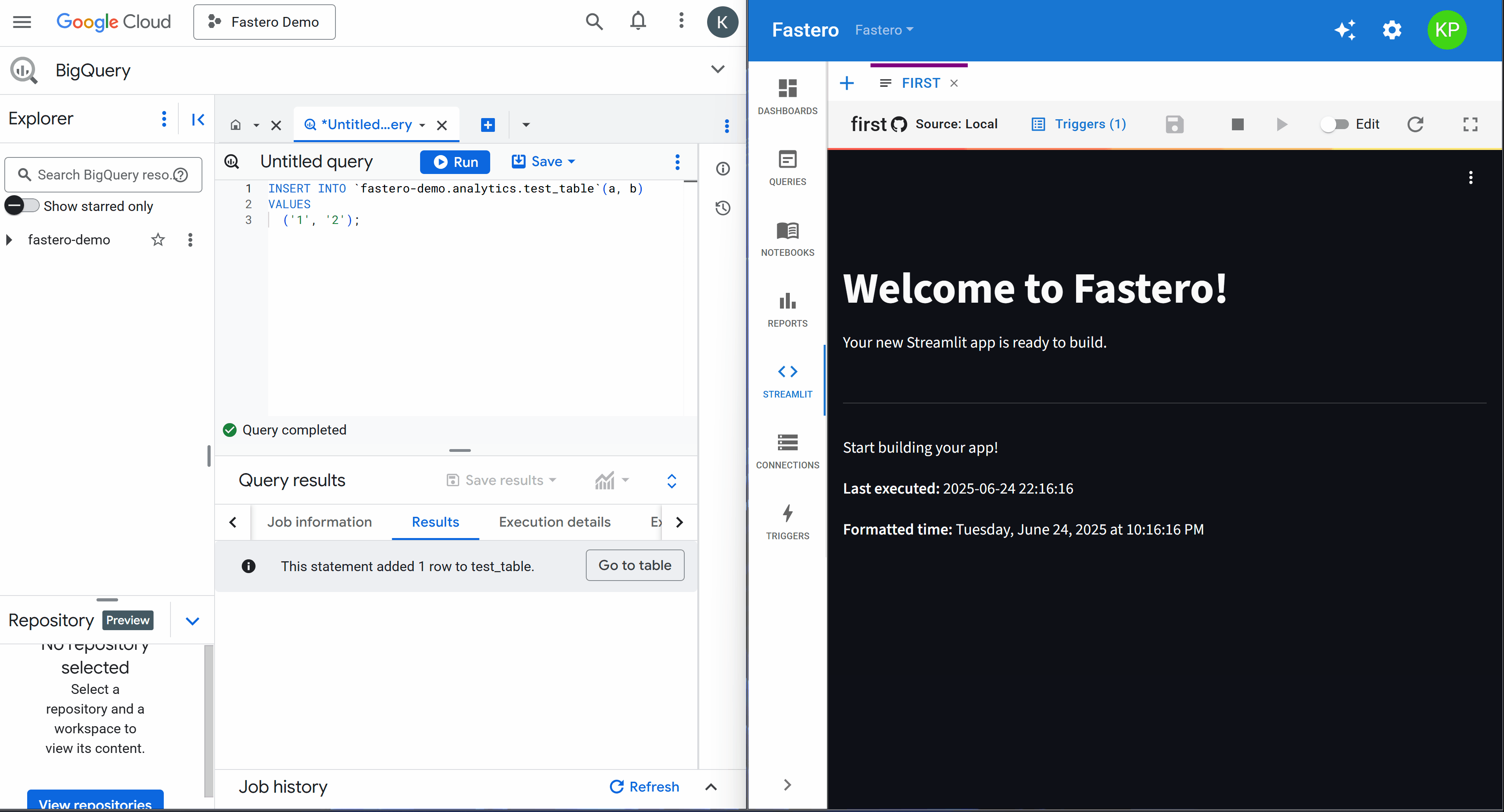Fastero vs Snowflake Streamlit
Both platforms offer hosted Streamlit applications with enterprise features, but they serve different architectural needs. Fastero provides cross‑database triggers and multi‑cloud flexibility, while Snowflake Streamlit offers deep native integration within the Snowflake ecosystem.

Key differences
Choose Fastero if you need:
- •Cross‑database event triggers (PostgreSQL + BigQuery + Snowflake)
- •Multi‑cloud deployment flexibility
- •Database‑agnostic trigger system
- •Unified analytics platform (notebooks + apps + workflows)
- •Fine‑grained project/org RBAC
Choose Snowflake Streamlit if you need:
- •100% Snowflake‑native architecture
- •Direct access to Snowflake data without movement
- •Seamless Snowflake role/security integration
- •Unified Snowflake billing and governance
- •Single vendor support and SLA
Detailed feature comparison
| Capability | Fastero | Streamlit Cloud | Snowflake Streamlit | Hex | Grafana |
|---|---|---|---|---|---|
| Hosted Streamlit | ✅ | ✅ | ✅ | ❌ | ❌ |
| Event‑driven auto‑reload | ✅ | ⚠️ | ⚠️ | ⚠️ | ⚠️ |
| Org/Project RBAC for apps | ✅ | ⚠️ | ✅ | ⚠️ | ⚠️ |
| File sync from DB (not just Git) | ✅ | ❌ | ❌ | ⚠️ | ❌ |
| Unified proxy (WS + embed‑friendly) | ✅ | ⚠️ | ✅ | ✅ | ✅ |
| Unified trigger system | ✅ | ❌ | ⚠️ | ✅ | ✅ |
| NL→SQL + notebooks together | ✅ | ❌ | ⚠️ | ✅ | ❌ |
* Competitor capabilities based on public documentation as of January 2025. Features may vary significantly by plan, configuration, and implementation.
We strive for accuracy but recommend verifying current capabilities directly with each vendor as features evolve rapidly.
Architecture comparison
🌐 Fastero: Cross‑database architecture
Fastero connects to multiple databases simultaneously and can trigger Streamlit app updates from changes in any connected system. Apps can join data across PostgreSQL, BigQuery, Snowflake, and other sources in real‑time.
❄️ Snowflake Streamlit: Native ecosystem
Snowflake Streamlit runs directly within Snowflake accounts with native access to all Snowflake features, security, and data. Apps can use Snowflake streams, tasks, and events for reactive behavior.
Real‑world scenarios
Better fit for Fastero:
Multi‑cloud analytics dashboard: A company with data in PostgreSQL (transactional), BigQuery (marketing), and Snowflake (finance) needs a unified customer 360 view. Fastero can trigger app updates from changes in any database and join data across all three sources.
Better fit for Snowflake Streamlit:
Snowflake‑native data science workflow: A team that already uses Snowflake for all data storage, processing, and ML workloads. They want apps that leverage Snowflake's native ML functions, security model, and compute scaling without any external dependencies.
Pricing considerations
Fastero pricing model
- • Usage‑based analytics platform pricing
- • Separate from your data warehouse costs
- • Cross‑database query optimization
- • Project‑based billing and quotas
Snowflake Streamlit pricing
- • Included with Snowflake Enterprise or higher
- • Uses Snowflake compute credits
- • Native cost optimization features
- • Unified billing with data warehouse
Migration and integration
From Snowflake Streamlit to Fastero: Export your app code and recreate in Fastero's editor. Configure cross‑database connections and set up event triggers. Migration complexity depends on Snowflake‑specific functions used.
From Fastero to Snowflake Streamlit: Migrate apps that only use Snowflake data. Convert trigger logic to Snowflake streams/tasks. Leverage native Snowflake functions for better performance.
Hybrid approach: Use Snowflake Streamlit for Snowflake‑native apps and Fastero for cross‑database scenarios. Both platforms can coexist in enterprise architectures.
Related articles
Ready to compare hands‑on?
Try both platforms with your own data to see which architecture fits your needs. Fastero offers a 30‑day free trial with cross‑database connectivity.